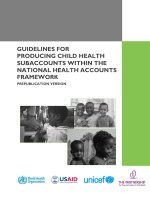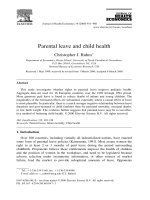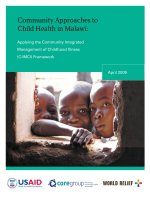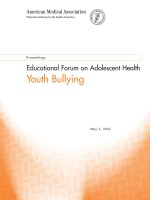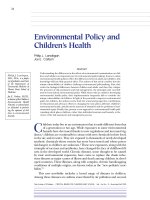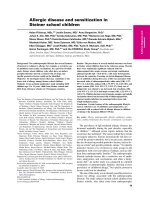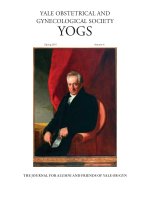Tài liệu Socio-demographic characteristics and sexual health related attitudes and practices of men having sex with men in central and southern Malawi doc
Bạn đang xem bản rút gọn của tài liệu. Xem và tải ngay bản đầy đủ của tài liệu tại đây (149.38 KB, 7 trang )
Tanzania Journal of Health Research Volume 10, No. 3, July 2008124
Introduction
Human immunodeciency virus (HIV) infection is
a major public health problem in Malawi where an
estimated 12% of adults 15to 49years are infected
(NSO, 2005). HIV infection prevalence is much higher
among women attending antenatal care, where in urban
areasprevalenceestimatesof30%havebeenreported
since the late 1990s (Bello et al., 2006; Semba et al.,
1999). There is evidence however that prevalence
estimates and incidence of infection have reduced
somewhat and stabilized in recent years (Bello et al.,
2006; Hallet et al., 2006).
While the national effort to prevent further HIV
transmission and to provide treatment to all geographical
and diverse demographic groups of the population has
been scaled up, there has been ‘guarded’ interest in
interventions aimed to prevent HIV spread among men
having sex with other men (MSM) in the country. Same
sex male partnerships are illegal in Malawi and marriage
is only permitted in a heterosexual relationship. Muula
(2007a) has reported an analysis of newspaper articles in
the country on several aspects of homosexuality or men
having sex with men. The report suggested that MSM
was perceived as rare in the country, although the risk
of HIV transmission was recognised.
There is paucity of data on MSM in Africa.
Simooya et al. (1995) have reported on MSM in
prison environments in Zambia. Furthermore, MSM
isperceivedtoresultfromaforeigninuenceandisit
against the cultural tenets of Malawi. As a result some
key policy makers have denied the possibility of MSM
activity in the country (Muula, 2007a).
Considering the scale of the HIV epidemic in
Africa, limited data on MSM have come from sub-
Saharan Africa presumably because research assume
no public health problem or do not know how to
work with MSM in these settings where MSM is
illegal. The available evidence however highlights
to multiple opportunities for interventions that may
reduce health risk. In a study in South Africa, Parry
et al. (2008) have reported high HIV knowledge, low
prevention practice and associated drug use among
MSM. Baral et al. (2007) and Liu et al. (2006) have
reported that HIV prevalence is much higher among
MSM compared to the ‘general’ community. This has
also been shown in other settings such as Thailand and
China where studies on MSM in relation to HIV suggest
*
Correspondence: Dr. Adamson Muula; E-mail:
Socio-demographic characteristics and sexual health related attitudes
and practices of men having sex with men in central and
southern Malawi
P.R.T. NTATA
1
, A.S. MUULA
2*
and S. SIZIYA
3
1
Department of Sociology, Chancellor College, University of Malawi, Zomba, Malawi
2
Department of Community Health, College of Medicine, University of Malawi, Private Bag 360, Chichiri,
Blantyre 3, Malawi
3
Department of Community Medicine, School of Medicine, University of Zambia, Lusaka, Zambia
_________________________________________________________________________________________
Abstract: An exploratory study of men having sex with men (MSM) was conducted in central and southern
Malawi in order to understand their socio-demographic characteristics, sexual behaviours, and perceptions about
condentialityandstigma.Atotalof97menparticipatedinthestudyofwhom84(86.6%)wereintheagegroup
17-32years.Themajority,73(75.3%)ofMSMhadnevermarried,26(32.5%)reportednotalwaysusingcondoms
duringsexualintercourse,and23(23.7%)hadeverreceivedmoneyorgiftsinexchangeofsex.Only17(17.5%)
of the participants reported being exposed to HIV prevention messages targeted at MSM. Fear of sexual orientation
disclosureanddiscriminationwerereportedby27(30.7%)ofMSM.Manyofthestudyparticipantsreportedthat
HIV intervention programmes are not accessible to them. In conclusion, HIV intervention programmes may not
be reaching out to the majority of MSM. We suggest an exploration of the feasibility of HIV prevention interven-
tions targeting MSM in this country where the practice is illegal.
_________________________________________________________________________________________
Key words: sexual orientation, men, attitudes, practices, HIV, prevention, Malawi
Tanzania Journal of Health Research Volume 10, No. 3, July 2008 125
that HIV prevalence may be much higher than the
‘general’ or heterosexual population (CDC, 2006; Liu
et al., 2006). However differences in risk behaviours
among MSM between different settings may occur
(Parry et al., 2008). Recently, Sanders et al., (2007) have
reportedthatlessthan2%ofMSMinKenyawereusing
illicit drugs whereas in South Africa the prevalence
hasbeenreportedtoexceed25%(Parryet al., 2008).
Overall however, a review of HIV prevalence among
MSMs across the world found no reliable estimates of
HIV prevalence from Africa (Cáceres et al., 2006).
Despite the above these considerations, the
Malawi National AIDS Commission in collaboration
with the Department of Correctional Services facilitated
the drafting of legislation that will allow conjugal visit
among incarcerated males in order to ‘prevent’ MSM
activity within prisons. In some sense therefore this is
an acknowledgement of the practice of MSM within
prison environments. The prevalence of MSM outside
prison and jails in Malawi remains understudied and
under-appreciated. This exploratory study aimed at
understanding MSM socio-demographic characteristics,
sexual health related attitudes and practices. It is
envisaged that this information may encourage research
and programmatic interest in efforts aimed to prevent
the spread of HIV in Malawi.
Materials and Methods
Study area
The study was conducted in the central and southern
regions of Malawi and included Blantyre, Zomba,
Lilongwe, Machinga, Mangochi and Dedza. These
districts were purposefully selected. Anecdotal evidence,
including media reports, suggested that most same-
sex activities were more concentrated in these areas.
The selected regions are the most socio-economically
developed districts in Malawi.
Study participant recruitment and questionnaire
administration
A snowballing method was used to recruit MSM from
the general community in November 2006. Initially,
seven MSM were identied and requested to recruit
potential participants who were known to them as men
having sex with men. A standard questionnaire was
administered to the study participants by trained research
staff. Information sought included: age; marital status;
residence (urban, peri-urban, rural); educational level;
sexual practices; disclosure of sexual orientation and
preferences and HIV prevention measures.
Data analysis
Data were analysed using SPSS version 14.0 (SPSS,
Chicago, Illinois, United States of America). Frequency
and proportions of selected socio-demographic
variables, knowledge, perceptions and behaviours were
obtained. Residence status was categorised as “urban,
semi-urban and rural” as per Malawi National Statistical
Ofce guidelines (Muula, 2007b).These guidelines
denerural,urbanandperi-urbanareastatusbasedon
adecisionbytheOfceofPresidentandCabinetand
not based on development indicators or population
congregation as is the case elsewhere (Magee, 2000;
Crandall & Weber, 2005).
Ethical considerations
All respondents participated only after giving verbal
informed consent. Only men who were having sex with
other men were involved in questionnaire distribution
and collection. The involvement of MSM as research
assistants possibly minimised potential stigma and
discrimination. This study was exempt from full ethical
review by the National Research Council of Malawi.
Results
A total of 97 men having sex with men (MSM) were
recruitedandparticipatedinthestudyand83.5%,8.2%
and8.2%werefromurban,peri-urbanandruralresidence
respectively. Most, 73 (75.3%) of MSM reported
being residents of Lilongwe, Zomba or Blantyre, the
three cities in the southern and central region of the
country,12.4%wereresidentsofLiwonde,andtherest
(12.3%)wereresidentsofMangochi,Balaka,Dedza,
andMozambique.ThemajorityofMSM,94(96.9%)
were of Malawiannationality,73 (75.3%) hadnever
been married, and 90 (92.8%) were Christians. The
age distribution of the participants was as follows: 17
(17.5%)MSMwereingroup18-22years,47(48.5%)
in23-27years,20(20.6%)in28-32years,10(10.3%)
in33-37years,and3(3.1)wereintheagegroup≥38
years.MostofMSM,67(69.1%)hadnochildren,17
(17.5%)hadonechild,and13(13.45)haduptove
children. Further socio-demographic description of the
study participants is reported in Table 1.
Tanzania Journal of Health Research Volume 10, No. 3, July 2008126
Table 1: Socio-demographic characteristics of men having sex with men in Malawi
Factor Response
Total
n (%)
Age group (years)
<28 ≥28
n (%) N (%)
Marital status Never married 73 (75.3) 58 (90.6) 15 (45.5)
Ever married to female* 24 (24.7) 6 (9.4) 18 (54.6)
Education Up to secondary 49 (50.5) 36 (56.3) 13 (39.4)
Post-secondary 48 (49.5) 28 (43.7) 20 (60.6)
Religion Christian 90 (92.8) 60 (93.8) 30 (90.9)
Other** 7 (7.2) 4 (6.3) 3 (9.1)
Race Black 91 (93.8) 60 (93.8) 31 (93.9)
Other 6 (6.2) 4 (6.3) 2 (6.1)
Nationality Malawi 94 (96.9) 64 (100) 30 (90.9)
Other 3 (3.1) 0 (0) 3 (9.1)
Occupation Student in school 14 (14.4) 11 (17.2) 3 (9.1)
Student in college 12 (12.4) 11 (17.2) 1 (3.0)
Professional*** 39 (40.2) 18 (28.1) 21 (63.6)
Business 18 (18.6) 13 (20.3) 5 (15.2)
Other 14 (14.4) 11 (17.2) 3 (9.1)
Notes: * ever married include currently married (19), divorced (2), and co-habiting (3); ** other include: Moslem (6), ***include: teachers,
health professionals, accountants
Table 2: Sexual practices among men having sex with other men in Malawi
Factor Response
Total Age group (years)
<28 ≥28
n (%) n (%) n (%)
Ageatrstsexualactivity(years) <16 36 (37.1) 25 (39.1) 11 (33.3)
16+ 61 (62.9) 39 (60.9) 22 (66.7)
Whom do you desire to have sexual relationship with? Men only 47 (48.5) 36 (56.3) 11 (33.3)
Other 50 (51.5) 28 (43.8) 22 (66.8)
Ever had anal penetration with someone who didn’t want
to use a condom
Yes 21 (21.6) 15 (23.4) 6 (18.2)
No 76 (78.4) 49 (76.6) 27 (81.8)
Always used condom Yes 54 (67.5) 35 (68.6) 19 (65.5)
No 26 (32.5) 16 (31.4) 10 (34.4)
Ever had sex with another man to receive money or gift Yes 23 (23.7) 17 (26.6) 6 (18.2)
No 74 (76.3) 47 (73.4) 27 (81.8)
Did anything to protect self from HIV/AIDS and other sexu-
ally transmitted infections
Yes 82 (84.5) 53 (82.8) 29 (87.9)
No 15 (15.5) 11 (17.2) 4 (12.1)
Justunderhalf(48.5%)ofMSMreportedthattheywere
attracted to men only, 23 (23.7%) reported that they
had ever had sex in exchange for money or gifts, and
26(32.5%)reportedthattheydidnotconsistentlyuse
condoms (Table 2).
Tanzania Journal of Health Research Volume 10, No. 3, July 2008 127
Table 3: Knowledge about men having sex with other men and HIV in Malawi
Factor Response
Total Age group (years)
<28 ≥28
N (%) n (%) n (%)
Agewhenrstheardofthetermho-
mosexuality
<16 years 38 (39.2) 29 (45.3) 9 (27.2)
≥16years 59 (60.8) 35 (54.7) 24 (72.7)
Placewhererstheardofhomosexu-
ality
Home 9 (9.3) 6 (9.4) 3 (9.1)
School 44 (45.4) 27 (42.2) 17 (51.5)
Electronic/media 24 (24.7) 17 (26.6) 7 (21.2)
Friends 20 (20.6) 14 (21.9) 6 (18.2)
Ever received any health messages
targeting MSM
Yes 17 (17.5) 10 (15.6) 7 (21.2)
No 80 (82.5) 54 (84.4) 26 (78.8)
Ever discussed homosexuality in rela-
tion to HIV/AIDS
Yes 69 (71.1) 44 (68.8) 25 (75.8)
No 28 (28.9) 20 (31.3) 8 (24.2)
Ever gone for VCT Yes 57 (58.8) 37 (57.8) 20 (60.6)
No 40 (41.2) 27 (42.2) 13 (39.4)
Themajority(90.6%)ofMSM feltcomfortablewith
theirsexualorientation.Despiteofthis,and90.7%had,
however, kept their sexual orientation secret from friends
andfamilymembers.Some56.4%oftheparticipants
reported having ever denied that they were MSM but
34%wishedthatotherpeopleknewabouttheirsexual
orientation.Twenty(30.7%)oftheparticipantsreported
that they feared stigma and discrimination should they
disclose to other people that they were MSM. Among
those who reported to have disclosed to other people
thattheywereMSM,28(28.9%)haddisclosedtoclose
friends,12(12.4%)toworkmates,6(6.2%)tofamily
members and 1 to a marital partner (Table 4).
Closetohalf(45.4%)hadheardaboutMSMinschool,
and 39.2% had known about MSM before attaining
theageof16years.However,only17(17.5%)ofthe
respondents reported being exposed to HIV prevention
messagestargetingMSM.Some58.8%oftheMSMhad
ever obtained HIV voluntary counselling and testing
services (Table 3).
Tanzania Journal of Health Research Volume 10, No. 3, July 2008128
Table 4: Attitudes among men having sex with men in Malawi, 2007
Factor Response
Age group (years)
Total <28 ≥28
n (%) n (%) n (%)
Comfortable with sexual orientation Yes 87 (90.6) 59 (93.7) 28 (84.8)
No 9 (9.4) 4 (6.3) 5 (15.2)
Sexual orientations kept secret from
non-MSM friends/ family
Yes 88 (90.7) 59 (92.2) 29 (87.9)
No 9 (9.3) 5 (7.8) 4 (12.1)
Reasons for keeping secret Fear of parents/ relatives 45 (51.1) 35 (58.3) 10 (34.5)
Fear of stigma 27 (30.7) 18 (30.0) 9 (31.0)
Others 16 (18.2) 6 10 (34.5)
Ever denied being gay Yes 53 (56.4) 39 (62.9) 14 (43.8)
No 41 (43.6) 23 (37.1) 18 (56.3)
Would want other people who are not
gay to know your sexual orientation
Yes 33 (34.0) 23 (35.9) 10 (30.3)
No 64 (66.0) 41 (64.1) 23 (69.7)
Wished sometimes that was not
MSM
Yes 35 (36.8) 22 (35.5) 13 (39.4)
No 60 (63.2) 40 (64.5) 20 (60.6)
Ever tried to change from being
MSM
Yes 23 (24.0) 14 (22.2) 9 (27.3)
No 73 (76.0) 49 (77.8) 24 (72.7)
Discussion
In an exploratory study of MSM in Malawi, we report
several socio-demographic and sexual behavioural
variables. As an exploratory study with a snowballing
sampling, this study provides critical data that will
potentially improve our understanding on the issue
of MSM in a southern African country where MSM
is illegal and HIV prevalence in the general adult
population is estimated at 12% (NSO, 2005).This
study though, being cross sectional in design and not
a probability sample, we can neither ascribe causation
to any of the factors identied or conrm that the
frequencies and proportions of the various attributes
studied are representative of the general MSM
population in Malawi. Furthermore, because of the
snowballing nature of participant recruitment, it is likely
that respondents recruited potential respondents who
were similar to themselves or within their own sexual
networks (Rubin et al., 1994). Study participants also
self-reported in response to the questions asked. Gallo
et al. (2007) found that sex workers in Kenya under-
reported unprotected sexual intercourse which was
detected via biomarkers of semen. In a study like ours,
there is also a possibility that respondents may have
mis-reported either intentionally or inadvertently. The
use of data collection assistants who were also MSM
was intended to minimise intentional mis-reported as
we expected that study participants were likely to be
open to other MSM.
Despite the limitations of the study as outlined
above,thereareseveralkeyndingsworthconsideration.
These are that marriage with females is not rare among
MSM; individuals are introduced to know about
MSM early on in life; individuals get to know about
homosexuality in diverse settings and largely in schools
andthemajorityidentiedinthisstudywereMalawian
nationals. Furthermore, unprotected sexual intercourse
was reported by about a third and the majority of the
respondents had not been exposed to HIV prevention
messagesspecicallytargetingMSM.Mostofthestudy
participants were well aware of the legal provisions
proscribing MSM, and feared stigma and discrimination
from the society around them.
Tanzania Journal of Health Research Volume 10, No. 3, July 2008 129
The current legal situation of MSM in Malawi
is problematic. It is illegal for men to have sex with
other men. In an environment where HIV infection
prevalenceinadultsis12%andwiththe“bridging”or
mixing between heterosexual and MSM populations,
the challenge is how public health HIV prevention
programmes designers and implementers deliver
services that would be accessible and appropriate
to all people within the country despite their sexual
orientations and behaviours?
According to the PRECEED/PROCEED model
of health promotion (Green & Kreuter, 1991), an
individual is likely to adopt a healthy behaviour if
she/he has the appropriate knowledge, attitude, and is
exposed to reinforcing and enabling factors (friends,
family and health workers). In Malawi, it appears that
MSM do not have access to relevant HIV messages that
will potentially inuence their knowledge levelsand
attitudes. The limited understanding of risks associated
with MSM may lead to failure in recognising and
protecting oneself from high risk sexual behaviours.
Furthermore, the fact that many MSM may hide their
sexuality from signicant others and possibly health
care workers, may result in their missing out from the
available preventive services.
Designing and providing prevention messages and
other programmes in an environment where the primary
behaviourisillegalis difcultbutnotimpossible. In
selected settings in Europe, Asia and North America,
useofspecicnarcoticandpsycho-stimulantdrugsis
illegal. Yet, programs commonly referred to as “harm
reduction” initiatives are implemented (Christie et al.,
2008; Paterson & Panessa, 2008). Although it may
appear a strange concept in most African settings,
various forms of ‘harm reduction’ programmes are
already being implemented in the prevention of HIV.
For instance, in many cultures and religions, concurrent
sexual partnerships, extra-marital and pre-marital sex
are discouraged. Encouraging correct and consistent
condom use where sexual intercourse occurs in such
situations has potential to prevent HIV spread, thereby
minimize the adverse effect that may have occurred
following or during a society-proscribed activity.
Appropriate HIV prevention messages and other
interventions targeting MSM are therefore required in
Malawi in order to curb the spread of HIV and other
sexually transmitted infections among MSM. Léobon
& Frigault (2008) reminds researchers and programme
planners that MSM are a heterogeneous group with
different socio-demographic characteristics. Our study
has shown too that MSM were not a homogenous group.
Young and old, married and unmarried, rural and urban,
andofreligiouspersuasionsselfidentiedthemselves
as MSM. Interventions programmes would have to take
these differences in consideration in approach in order
tobesufcientlyeffective.
In conclusion, HIV intervention programmes
may not be reaching out to the majority of MSM. We
suggest an exploration of the feasibility of effective HIV
prevention interventions targeting MSM in this country,
where MSM is illegal. Simooya et al. (2001) in a study
in Zambia have reported the difculty in providing
condoms in prisons for MSM when the practice is illegal
in that country. We believe that even outside the prison
environment, policy makers often have dilemma on how
to provide prevention services when same sex practices
are illegal. We are also unaware of any studies that have
assessed HIV or other sexually transmitted infections
prevalence among MSM in Malawi. We propose that
studies be designed to obtain these data.
Conict of interest
The authors declare that they have no conflict of
interest.
Acknowledgements
We are grateful to all men who accepted to be study
participants. Funding for the study was obtained from
the Harare ofce of the Humanistisch Instituut voor
Ontwikkelingssamenwerking (HIVOS), a Dutch non-
governmental organization.
______________________
Received 17 April 2008
Revised 20 May 2008
Accepted 21 May 2008
References
Baral, S., Sifakis, F., Cleghorn, F. & Beyrer, C. (2007)
Elevated risk for HIV infection among men who
have sex with men in low- and middle-income
countries 2000-2006: a systematic review. PLoS
Medicine 4 (12), e339.
Bello, G.A., Chipeta, J. & Aberle-Grasse, J. (2006)
Assessment of trends in biological and
behavioural surveillance data: is there any
evidence of declining HIV prevalence or
incidence in Malawi? Sexually Transmitted
Infections 82 (Suppl 1), i9-13.
Cáceres, C., Konda, K., Pecheny, M., Chatterjee, A.
& Lyerla, R. (2006) Estimating the number
of men who have sex with men in low and
middle income countries. Sexually Transmitted
Tanzania Journal of Health Research Volume 10, No. 3, July 2008130
Infections 82 (Suppl 3), iii3-9.
CDC (2006) HIV prevalence among populations of men
who have sex with men-Thailand, 2003 and
2005. Mortality and Morbidity Weekly Report
55, 844-848.
Christie, T., Groarke, L. & Sweet, W. (2008) Virtue
ethics as an alternative to deontological and
consequential reasoning in the harm reduction
debate. International Journal on Drug Policy
19, 52-58.
Crandall, M. & Weber B. (2005) Dening Rural Oregon:
an Exploration. Oregon: Rural Studies Program,
Oregon State University, p 13.
Gallo, M.F., Behets, F.M., Steiner, M.J., Thomsen, S.C.,
Ombidi, W., Luchters, S., Toroitich-Ruto, C. &
Hobbs, M.M. (2007) Validity of self-reported
‘safe sex’ among female sex workers in
Mombasa, Kenya-PSA analysis. International
Journal of Sexually Transmitted Diseases and
AIDS 18, 33-38.
Green L.W. & Kreuter M.W. (1991) Health promotion:
An Educational and Environmental Approach.
(2
nd
Edition), Mountain View, Mayfield,
California, United States of America.
Hallett, T.B., Aberle-Grasse, J., Bello, G., Boulos, L.M.,
Cayemittes, M.P., Cheluget, B., Chipeta, J.,
Dorrington, R., Dube, S., Ekra, A.K., Garcia-
Calleja, J.M., Garnett, G.P., Greby, S., Gregson,
S., Grove, J.T., Hader, S., Hanson, J., Hladik,
W., Ismail, S., Kassim, S., Kirungi, W., Kouassi,
L., Mahomva, A., Marum, L., Maurice, C.,
Nolan, M., Rehle, T., Stover, J. & Walker, N.
(2006) Declines in HIV prevalence can be
associated with changing sexual behaviour in
Uganda, urban Kenya, Zimbabwe, and urban
Haiti. Sexually Transmitted Infections 82 (Suppl
1), i1-8.
Léobon, A. & Frigault, L.R. (2008) Frequent and
systematic unprotected anal intercourse among
men using the Internet to meet other men for
sexual purposes in France: results from the
“Gay Net Barometer 2006” Survey. AIDS Care
20, 478-484.
Liu, H., Yang, H., Li, X., Wang, N., Liu, H., Wang,
B., Zhang, L., Wang, Q. & Stanton B. (2006).
Men who have sex with men and human
immunodeciency virus/sexually transmitted
disease control in China. Sexually Transmitted
Diseases 33, 68-76.
Magee, G.C. (2000) Procedural skills rurality index for
the medical community. Canadian Journal of
Rural Medicine 5, 8.
Muula, A.S. (2007a) Perceptions about men having
sex with men in southern African country:
case study of print media in Malawi. Croatian
Medical Journal 48, 398-404.
Muula,A.S. (2007b) How do wedene ‘rurality’ in
the teaching on medical demography? Rural
and Remote Health, 7(1):653. Available from:
NSO(2005)NationalStatisticalOfceandORCMacro.
Malawi Demographic and Health Survey 2004.
Calverton, Maryland: NSO and ORC Macro.
Parry, C., Petersen, P., Dewing, S., Carney, T., Needle,
R., Kroeger, K. & Treger, L. (2008) Rapid
assessment of drug-related HIV risk among
men who have sex with men in three South
African cities. Drug and Alcohol Dependence
95, 45-53.
Paterson, B.L. & Panessa, C. (2008) Engagement as an
ethical imperative in harm reduction involving
at-risk youth. International Journal on Drug
Policy 19, 24-32.
Rubin, K.H., Lynch, D., Coplan, R., Rose-Krasnor, L.
& Booth, C.L. (1994) “Birds of a feather ”:
behavioral concordances and preferential
personal attraction in children. Child
Development 65, 1778-1785.
Sanders, E.J., Graham, S.M., Okuku, H.S., van der
Elst, E.M., Muhaari, A., Davies, A., Peshu,
N., Price, M., McClelland, R.S. & Smith, A.D.
(2007) HIV-1 infection in high risk men who
have sex with men in Mombasa, Kenya. AIDS
21, 2513-2520.
Semba, R.D., Kumwenda, N., Hoover, D.R., Taha,
T.E., Quinn, T.C., Mtimavalye, L., Biggar, R.J.,
Broadhead, R., Miotti, P.G., Sokoll, L.J., van der
Hoeven, L. & Chiphangwi, J.D. (1999) Human
immunodeciency virus load in breast milk,
mastitis, and mother-to-child transmission of
humanimmunodeciencyvirustype1.Journal
of Infectious Diseases 180, 93-98.
Simooya, O., Phiri, A., Sanjobo, N. & Sichilima, W.
(1995) Sexual behaviour and issues of HIV/
AIDS prevention in an African prison. AIDS
9, 1388-1389.
Simooya, O.O., Sanjobo, N.E., Kaetano, L., Sijumbila,
G., Munkonze, F.H., Tailoka, F. & Musonda,
R. (2001) ‘Behind walls’: a study of HIV risk
behaviours and seroprevalence in prisons in
Zambia. AIDS 15, 1741-1744.

